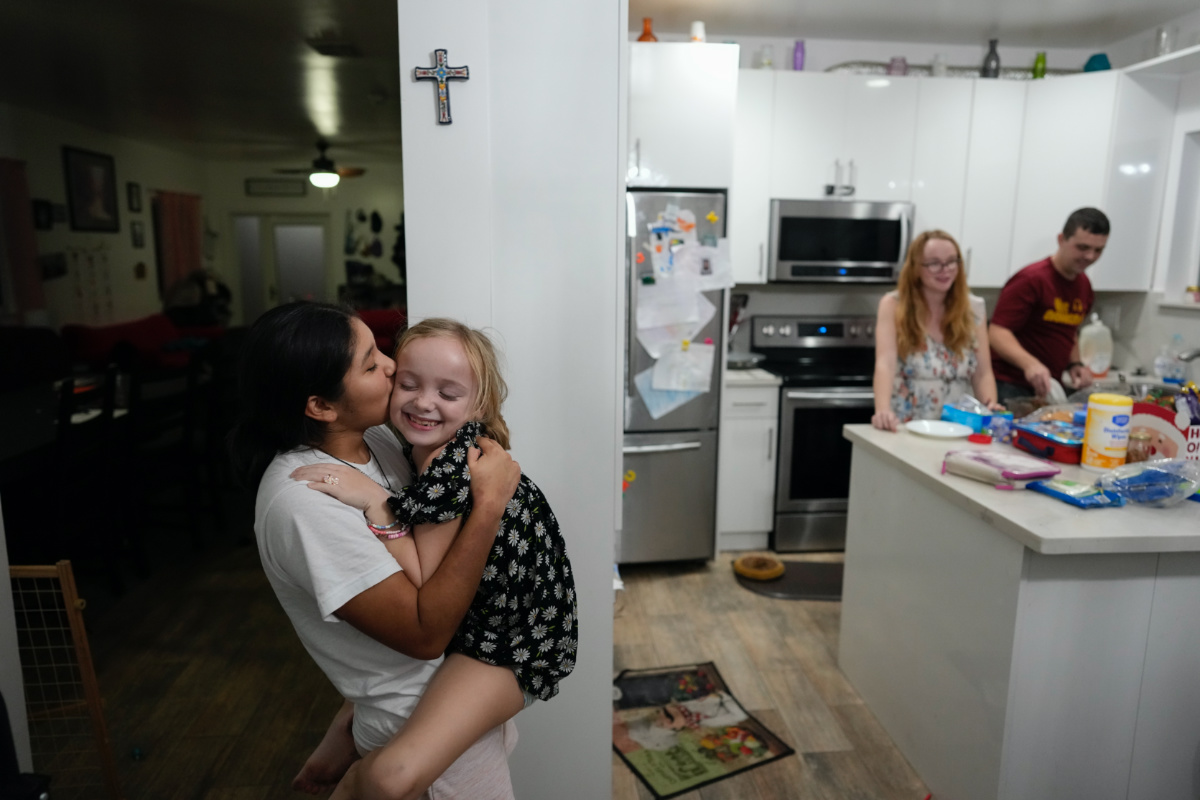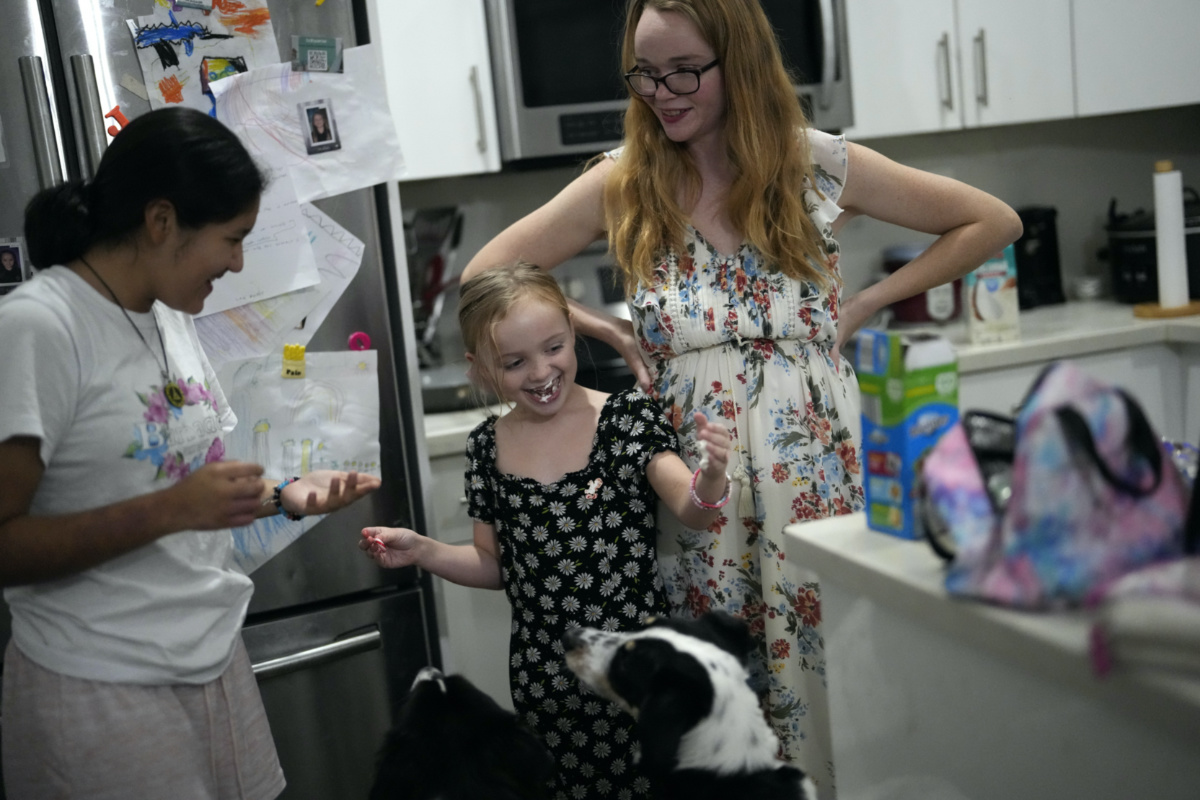
GIOVANNA DELL’ORTO, of Associated Press, reports on how migrant children who arrived alone in the US are being cared for – and the need for more foster families…
Homestead, Florida
AP
Snuggling on the sofa across from the Christmas tree, Sol proudly showed off the dog her foster parents gave her for earning all A’s even though she crossed the southern US border knowing very little English.
“They helped me a lot,” said the 14-year-old eighth grader. Then she blushed, hid her face in Cosmo’s fur, and added in Spanish, “Oooh, I said that English!”

Sol, left, a 14-year-old from Argentina, kisses eight-year-old Maddie Hazelton as they play together in the kitchen of Sol’s foster parents, Andy, right, and Caroline Hazelton, in Homestead, Florida, on Monday, 18th December, 2023. Sol is among tens of thousands of children who have arrived in the United States without a parent during a huge surge in immigrants that’s prompting congressional debate to change asylum laws. PICTURE: AP Photo/Rebecca Blackwell.
Sol – who is from Argentina – is among tens of thousands of children who arrive in the United States without a parent, during a huge surge in immigrants that’s prompting congressional debate to change asylum laws.
Faith and community groups across the country are trying to recruit many more foster families to help move the children from overwhelmed government facilities. US authorities encountered nearly 140,000 unaccompanied minors at the border with Mexico in fiscal year 2023, according to US Customs and Border Protection. Almost 10,000 are still in custody of the Department of Health and Human Services’ Office of Refugee Resettlement, according to its latest data.
“It’s amazing the quantity of children who are coming.”
– Mónica Farías, who leads the Unaccompanied Refugee Minors Program for Catholic Charities of the Archdiocese of Miami.
“It’s amazing the quantity of children who are coming,” said Mónica Farías, who leads the Unaccompanied Refugee Minors Program for Catholic Charities of the Archdiocese of Miami. “We’re actively recruiting parents.”
Program leaders have been going to churches and other community organizations every weekend to find more families like Andy and Caroline Hazelton, Sol’s foster parents.
Over the past four years, the Hazeltons – a couple in their early 30s living in a Miami suburb, with three biological daughters ages eight, six and almost two – have fostered five migrant minors for several months and more for shorter periods. Two teens were from Afghanistan, but most came from Central America.
“Our faith inspired us,” Andy Hazelton said, adding they felt the need to respond to the Gospel exhortation of helping others as one would help Jesus when they heard about families being separated at the border.
Like other foster families, the Hazeltons say they focus not on the often stridently divisive politics of immigration, but simply on assisting children in need. A globe ornament on their living room Christmas tree is marked with dots for the birthplaces of each family member.
“Every Christmas we have new kids in our home,” Caroline Hazelton said, adding that even the Muslim Afghan teens, who had never seen a stocking bulging with presents, quickly joined the festivities.

Sol, left, a 14-year-old from Argentina, and eight-year-old Maddie Hazelton joke around with some whipped cream as Sol’s foster mother, Caroline Hazelton, and the family’s two dogs look on, in Homestead, Florida, on Monday, 18th December, 2023. PICTUEE: AP Photo/Rebecca Blackwell.
Like most youths in these programs, those boys were eventually reunited with their birth family – the mother hugged Caroline for 10 minutes, sobbing in gratefulness. With Sol, whose father has gone missing on the journey across the desert, and other children without relatives in the United States, foster families’ commitments can last years.
As Sol packed her school lunch in a Stranger Things bag under Cosmo’s watchful eyes, the Hazeltons said they would be happy to have her stay forever and already refer to their four daughters.
Regardless of the length of stay, foster parents say they need to give the children enough stability to get comfortable with unfamiliar US customs – from air conditioning to strict school routines – and to learn more English.
“We’re never going to be like their parents. Thank God we live in a country where things can be easier,” said Carlos Zubizarreta. A foster child himself 50 years ago, he’s been a foster parent in the Miami area for about 30 children over nearly two decades, in addition to having biological, now adult children.
Nevertheless, he always finds it hard when each foster child leaves after they’ve shared nightly dinners, vacations, and household tasks like car maintenance. Zubizarreta plans to continue to foster as long as he feels that is what God is calling him to do.
In Baltimore, Jason Herring has been a foster father for a year, to five children from Central America through a program run by Lutheran Immigration and Refugee Service that focuses on short-term care for those whose return to biological parents is being assessed by the government.
He says he is not religious – initially, he feared he wouldn’t be accepted in the program for being gay. That led him to sympathise with the plight of children suffering because of adult decisions they have no power over.
“I understand what it feels to be the other,” he said. “You don’t have to be a perfect parent, just be there.”
Like all foster families, those taking in unaccompanied migrant children must be licensed by their state, and often receive extra training specific to immigration law and trauma, said Amanda Nosel, the Lutheran agency’s program manager for foster care in Baltimore.
“There’s certainly a national shortage in foster parents right now. We have so many kids who need homes,” Nosel said.

Andy Hazelton holds a globe ornament on which he and his wife have marked the home countries of migrant kids they have fostered, on the family’s Christmas tree in Homestead, Florida, on Monday, 18th December, 2023. PICTURE: AP Photo/Rebecca Blackwell.
Acclimating to a new country in a caring family setting is especially important given the deep and increasing level of trauma these children carry, from what they had to flee in their countries through the journey to the United States.
“It’s trauma on top of trauma on top of trauma. Kids are just living in survival mode,” said Sarah Howell, a clinical social worker in Houston with long experience counseling migrant children, including a teenage girl she’s raising.
They often internalize fear and grieving so much that they appear mature beyond their age, while still being terrified that any new familial relationship will abandon them. It takes a while before foster parents are relieved to see regular child or teen behavior make an appearance – even if that means refusing all but junk food or sibling bickering, it’s still a sign of normalcy.
“All of them are kids, but with an adult age,” said Bernie Vilar, who works as a mentor in a home for vulnerable youth, including those who age out of Miami’s Catholic Charities foster care. Vilar, 24, was homeless when he was younger, and he tries to pass on the passion for education that helped him survive that.
But he says many are too burdened by the debts they owe the smugglers who brought them to the US to be interested in anything but work, while others struggle with depression after witnessing death and violence on their journeys.
We rely on our readers to fund Sight's work - become a financial supporter today!
For more information, head to our Subscriber's page.
Brandon Garcia, 20, seems to have beaten the odds. After crossing alone at 15 because his parents told him he would have no opportunities in Guatemala’s Indigenous highlands, he spent six months living with the Hazeltons and is now in Vilar’s group home, finishing technical college.
He still misses his family, but loves the Hazeltons’ daughters as his own sisters. At a holiday party in a suburban Miami bowling alley organized by the Catholic Charities program, he played with them at intervals between bites of pizza and aiming for strikes with other young men.
Garcia said the speed of change as he adapted to the United States was hard, but he has never thought of going back. His happiest moment came when the Hazeltons brought him to Orlando’s theme parks – a holiday tradition that they plan to continue this year with Sol – and they watched the fireworks display.
“I felt the same happiness as with my family,” Garcia said. “I told myself, this is a country of great opportunities, and I have to take advantage of them.”






